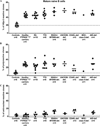The establishment of early B cell tolerance in humans: lessons from primary immunodeficiency diseases
- PMID: 22236425
- PMCID: PMC3925509
- DOI: 10.1111/j.1749-6632.2011.06347.x
The establishment of early B cell tolerance in humans: lessons from primary immunodeficiency diseases
Abstract
Patients with primary immunodeficiency (PID) provide rare opportunities to study the impact of specific gene mutations on the regulation of human B cell tolerance. Alterations in B cell receptor and Toll-like receptor signaling pathways result in a defective central checkpoint and a failure to counterselect developing autoreactive B cells in the bone marrow. In contrast, CD40L- and MHC class II-deficient patients only displayed peripheral B cell tolerance defects, suggesting that decreased numbers of regulatory T cells and increased concentration of B cell activating factor (BAFF) may interfere with the peripheral removal of autoreactive B cells. The pathways regulating B cell tolerance identified in PID patients are likely to be affected in patients with rheumatoid arthritis, systemic lupus erythematosus, and type 1 diabetes who display defective central and peripheral B cell tolerance checkpoints. Indeed, risk alleles encoding variants altering BCR signaling, such as PTPN22 alleles associated with the development of these diseases, interfere with the removal of developing autoreactive B cells. Hence, insights into B cell selection from PID patients are highly relevant to the understanding of the etiology of autoimmune conditions.
© 2011 New York Academy of Sciences.
Conflict of interest statement
The author declares no conflicts of interest.
Figures





References
-
- Edwards JCW, et al. Efficacy of B cell-targeted therapy with Rituximab in patients with rheumatoid arthritis. N. Engl. J. Med. 2004;350:2572–2581. - PubMed
-
- Hauser SL, et al. B-cell depletion with rituximab in relapsing-remitting multiple sclerosis. N. Engl. J. Med. 2008;358:676–688. - PubMed
-
- Wardemann H, et al. Predominant autoantibody production by early human B cell precursors. Science. 2003;301:1374–1377. - PubMed
Publication types
MeSH terms
Substances
Grants and funding
LinkOut - more resources
Full Text Sources
Other Literature Sources
Medical
Research Materials

